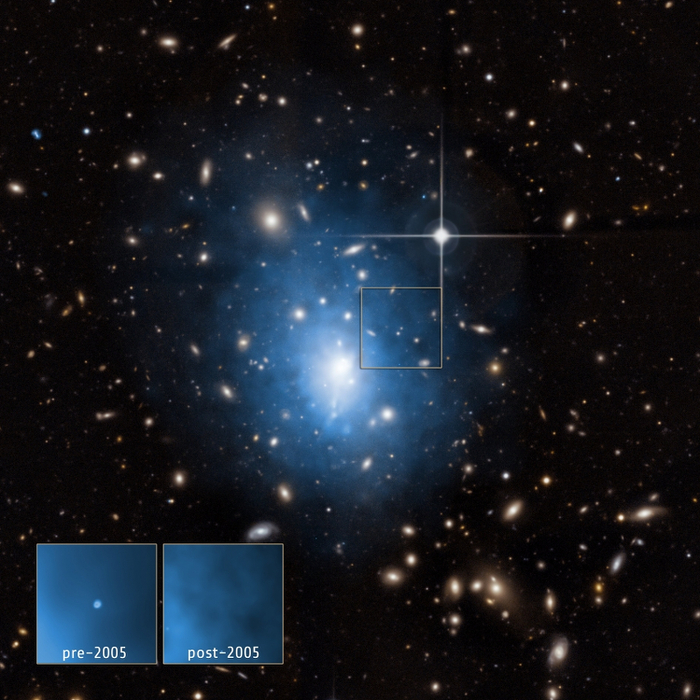
 Credit: X-ray: NASA/CXC/Univ. of Alabama/W.P. Maksym et al & NASA/CXC/GSFC/UMD/D. Donato, et al; Optical: CFHT
Credit: X-ray: NASA/CXC/Univ. of Alabama/W.P. Maksym et al & NASA/CXC/GSFC/UMD/D. Donato, et al; Optical: CFHT
The Swallowing?
Black holes are safe to orbit, as long as you don't get too close. If you do, there's a chance that something unfortunate might happen. Many have considered what happens to those daring wanderers who get too close and fall into a black hole. But theory perhaps met reality. Astronomers combing through the archive of observations by the Chandra X-ray Observatory found something unusual: a flash of X-rays from an otherwise non-descript dwarf galaxy in the cluster Abell
1795. The image above shows a Chandra X-ray image (in blue) of the cluster, superimposed on an optical image which shows the individual galaxies which belong to the cluster. The inset shows an X-ray bright object which was seen in 1999, and which faded away by 2005. In addition to the Chandra archival data, the flare was also probably observed in the ultraviolet by the Extreme Ultraviolet Explorer in 1998. The fading of the bright source is hard to explain, but astronomers believe the flare was produced when a star came close to, and was eventually swallowed by, a medium-mass black hole at the center of a dwarf galaxy in the Abell 1795 cluster. Sad to think if there were any planets orbiting that particular star. We may get a similar fireworks display when a giant gas cloud begins to fall into the Milky Way's supermassive black hole sometime this year.
Published: January 13, 2014
<
HEA Dictionary ● Archive
● Search HEAPOW
● Other Languages
● HEAPOW on Facebook
● Download all Images
● Education ● HEAD
>

Each week the HEASARC
brings you new, exciting and beautiful images from X-ray and Gamma ray
astronomy. Check back each week and be sure to check out the HEAPOW archive!
Page Author: Dr. Michael F. Corcoran
Last modified Monday, 26-Feb-2024 17:20:11 EST


